Vietnamese street food cuisine has garnered international acclaim, not just for its intrinsic flavors but also for how it reflects the vibrant culture and rich history of the country. When international friends think of Vietnam, they envision not only its S-shaped coastline, beautiful landscapes, and natural resources but also the dynamic street food scene that has become synonymous with Vietnamese culture.
This culinary tradition has been lauded by tourists and celebrated as one of the world's most delicious street food cuisines by reputable international media outlets.
Are you planning a visit to Vietnam and wish to delve into the rich tapestry of its street food culture, here is a selection of the best Vietnam street food to consider.
1. Phở (Rice noodle soup)
Phở, a quintessential Vietnamese soup, has etched its name into global cuisine, evidenced by its inclusion in the Oxford Dictionary. This recognition speaks volumes about its widespread appeal, transcending Vietnam's borders to capture the hearts of food enthusiasts worldwide.
Phở's foundation is a delectable broth, rice noodles (bánh phở), herbs, and meat, with beef being the traditional choice, though variations include chicken, duck, and goose to cater to diverse palates.
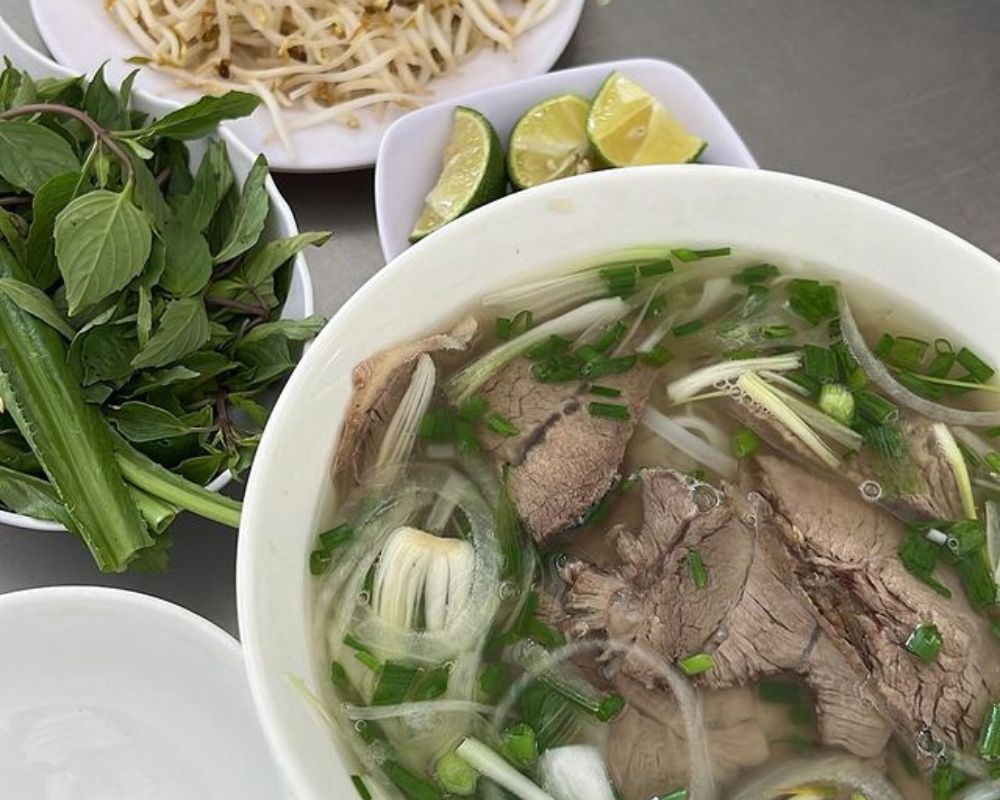
Phở with beef
A notable aspect of Phở is the regional variations between the Hanoi (northern) and Saigon (southern) styles. These differences manifest in the sweetness of the broth and the distinct flavors of the meats used, such as pork, beef, chicken, duck, or goose.
Additionally, the accompaniments and garnishes vary, offering a nuanced experience of this beloved soup. Whether in Hanoi or Saigon, Phở serves as a delicious ambassador of Vietnamese culture, embodying the rich diversity and culinary excellence of the country.
>> Read more: Top 17 Best Indian Restaurants in Ho Chi Minh
2. Bánh Mì (Vietnamese sandwich)
Bánh Mì is not just a culinary delight; it's a cultural emblem that captures the essence of Vietnam in every bite. Its rise to global fame is such that its name has been enshrined in the Oxford Dictionary, and it has even inspired national costume designs for international beauty pageants.
This reflects not only the dish's widespread appeal but also its deep-rooted significance in Vietnamese culture.
The origins of Bánh Mì can be traced back to the French colonial era in the nineteenth century. Originally a simple French baguette sandwich, it was transformed by the culinary creativity of the Saigonese.
They adapted it by filling the baguette with a variety of local ingredients such as eggs, pork, cucumber, and herbs, turning it into a quintessential Vietnam street food. This innovation marked the birth of a dish that would come to symbolize the fusion of Vietnamese flavors and French culinary tradition.
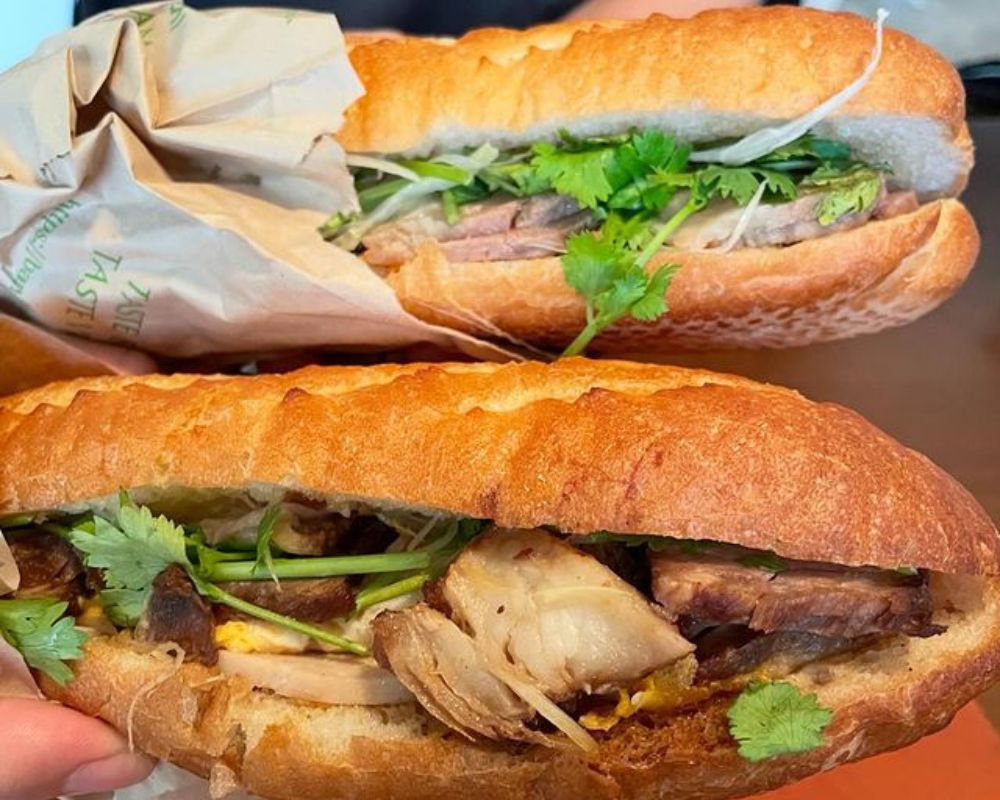
Bánh Mì
A typical Bánh Mì is comprised of a crispy baguette filled with a combination of savory ingredients: eggs, pate, pork, cucumber, tomatoes, carrots, herbs, and more, according to personal preference.
Its popularity is a testament to its deliciousness, with the warm bread, grilled pork or beef, and the crisp freshness of the herbs and vegetables combining to create a uniquely flavorful experience.
3. Gỏi Cuốn (Spring Rolls)
Gỏi cuốn, or fresh spring rolls, are a testament to the freshness of Vietnam Steet Food. Unlike their fried counterparts, these rolls are packed with fresh herbs, lettuce, vermicelli noodles, and slices of pork or shrimp, all neatly wrapped in clear rice paper.
They come with a side of peanut or hoisin dipping sauce, adding a sweet and savory touch to the delicate flavors of the roll.
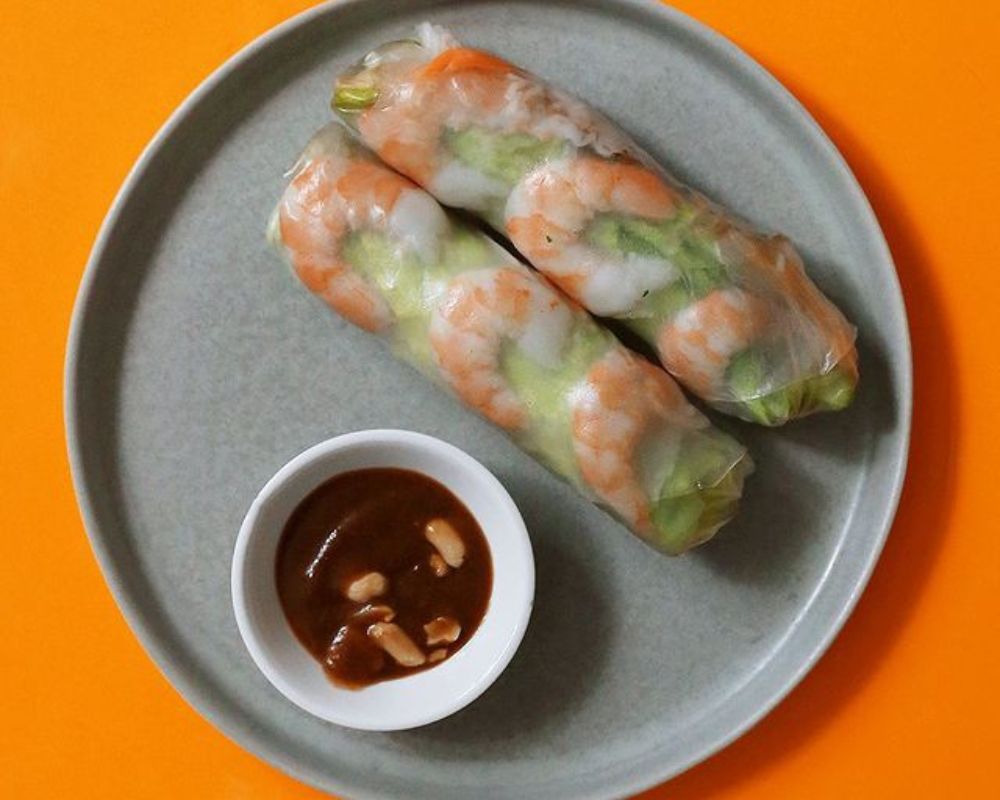
Gỏi Cuốn with shrimp
4. Bún Chả
Bún chả is a Hanoi street food that captures the essence of Vietnamese grilling. At its core, Bún Chả features a warm, savory broth alongside minced pork and traditional Vietnamese rice noodles.
When served, it comes as a harmonious ensemble: a plate of rice noodles, a rich collection of fresh herbs, and a bowl of warm broth teeming with succulent grilled minced pork. The magic of Bún Chả lies in the interplay of its components.
The broth, simmered to perfection, derives its subtle sweetness from pork bones, while the grilled pork captivates with its smoky aroma. Fresh herbs add a layer of crispness, elevating the dish with their vibrant flavors.
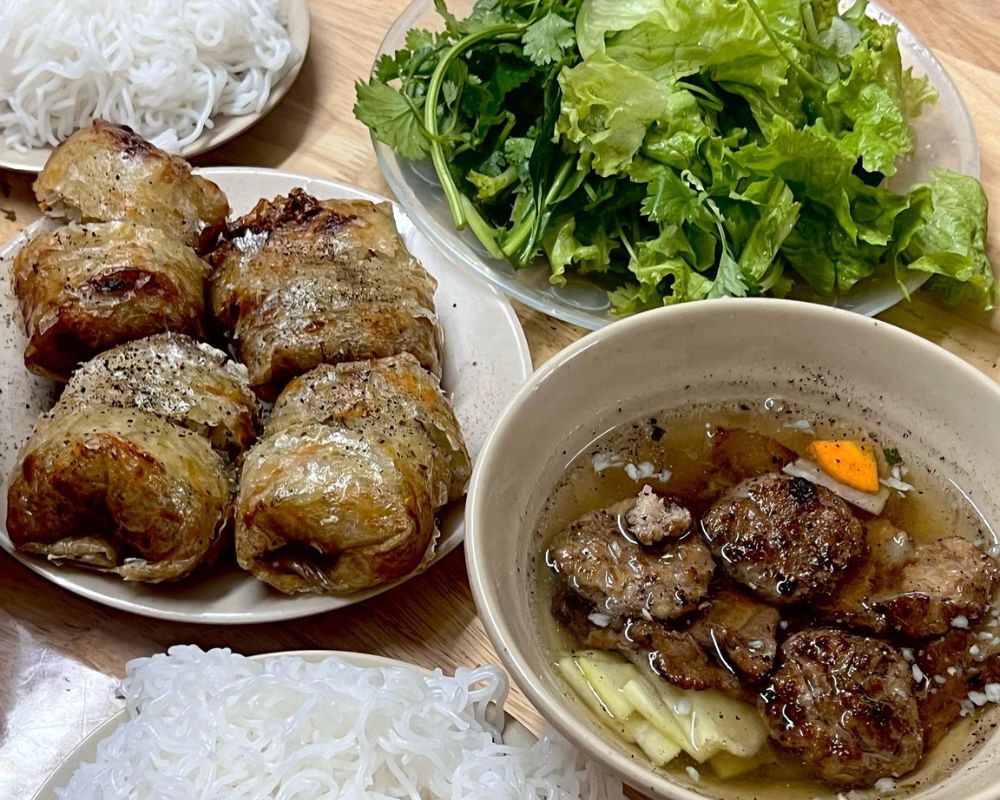
Bún Chả Hanoi
Eating Bún Chả is an experience akin to enjoying a Western soup but with a distinct Vietnamese twist. Diners immerse the rice noodles and grilled pork into the broth, savoring each bite as a blend of sweet, savory, and fresh flavors dance across the palate.
This dish is not just a meal; it's a journey through the heart of Hanoi's culinary excellence, offering a taste of the city's rich cultural heritage.
>> Read more: Top 15 Vietnamese Restaurants in Ho Chi Minh
5. Bánh tráng trộn (Mix Rice Paper Salad)
Bánh tráng trộn is a vibrant, textural delight made from shredded rice paper mixed with a variety of ingredients like green mango, dried shrimp, quail eggs, and a special sauce.
It's a popular snack among Vietnamese youth, known for its spicy, sweet, sour, and savory flavors. The crunch of the rice paper and peanuts, combined with the freshness of the herbs, makes it an irresistible treat.
6. Ốc (Snails)
A common delicacy offered at Vietnam street food stalls is sea snails! On occasion, you might stumble upon a specialized snail eatery, showcasing an array of fresh snails and shellfish ready for selection.

Some popular dishes made from snails
You have the luxury of choosing your preferred cooking method, whether it is frying, steaming, sautéeing, or grilling. Eating Ốc is a social activity, often enjoyed with friends and cold beers.
7. Bún bò Huế (Hue-styled beef noodles)
Bún bò Huế is a spicy beef noodle soup from the central city of Huế. It's known for its lemongrass-flavored broth, thick rice noodles, slices of beef, and often pig's feet.
The soup is enriched with a distinctive shrimp paste and chili oil, giving it a deep, complex flavor profile. Garnished with lime wedges, cilantro, onions, and other herbs, it's a hearty and warming dish.
8. Bánh Cuốn
Bánh Cuốn is another staple of Vietnamese street food, enjoyed at any meal as a main dish. Made from a thin, paper-like rice flour batter, it's filled with minced pork and wood ear mushrooms, similar to the filling of a spring roll, and served with a sprinkling of crispy fried shallots and a special sauce that balances spicy and sweet flavors.
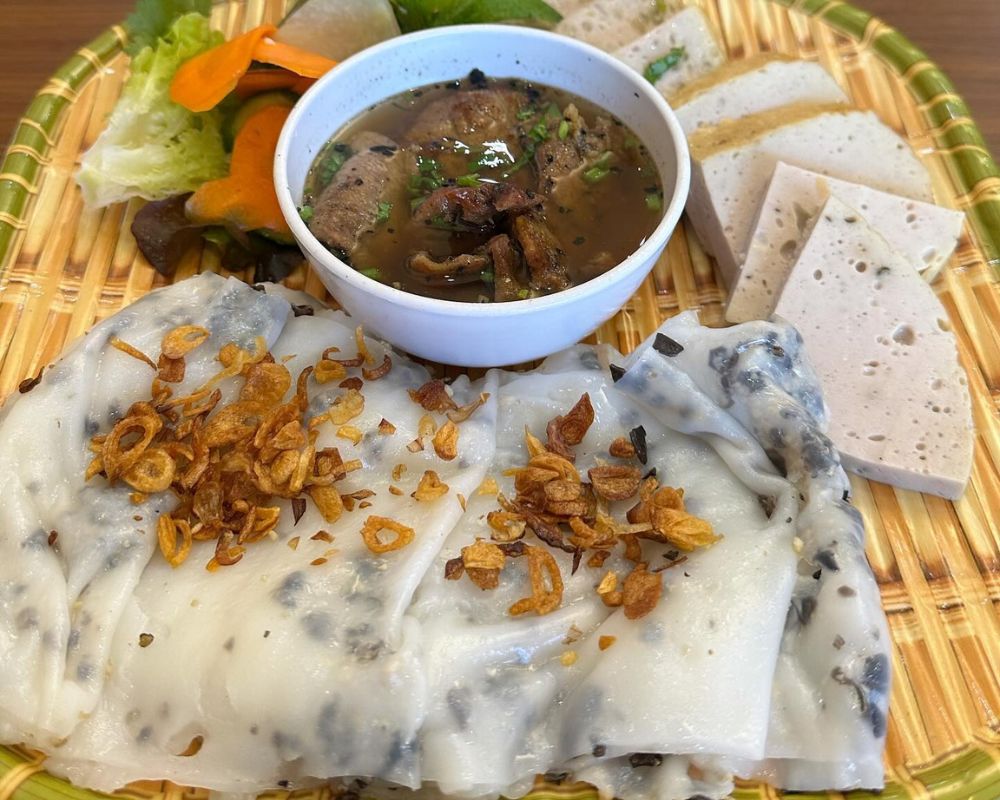
Bánh Cuốn with Chả
The dish is often accompanied by Chả (Vietnamese pork sausage), enhancing its taste. The preparation of Bánh Cuốn, particularly the smooth rice batter and the flavorful sauce, is a testament to the intricacy and richness of Vietnamese cuisine, offering a delicate balance of textures and flavors that is both satisfying and memorable.
9. Nem Ran (Fried Spring Rolls)
Nem Rán, also known as Chả Giò (Fried Spring Rolls), holds a beloved spot in Vietnamese cuisine, cherished across both northern and southern regions. Its fame extends beyond Vietnam's borders, gracing menus in restaurants worldwide, a testament to its universal appeal.
The construction of Nem Rán involves three key components: the wrapper, the filling, and the dipping sauce. The wrapper, crafted from rice flour, is rolled out into thin circles or squares, setting the stage for the flavorful filling.
This consists of a hearty mix of minced pork, eggs, carrots, mien (a traditional Vietnamese noodle), wood ear mushrooms, and fresh herbs.
Depending on regional preferences or personal tastes, the pork can be substituted with seafood like shrimp or even beef, showcasing the dish's versatility. Once mixed, the ingredients are enveloped in rice paper, neat little rolls for frying.
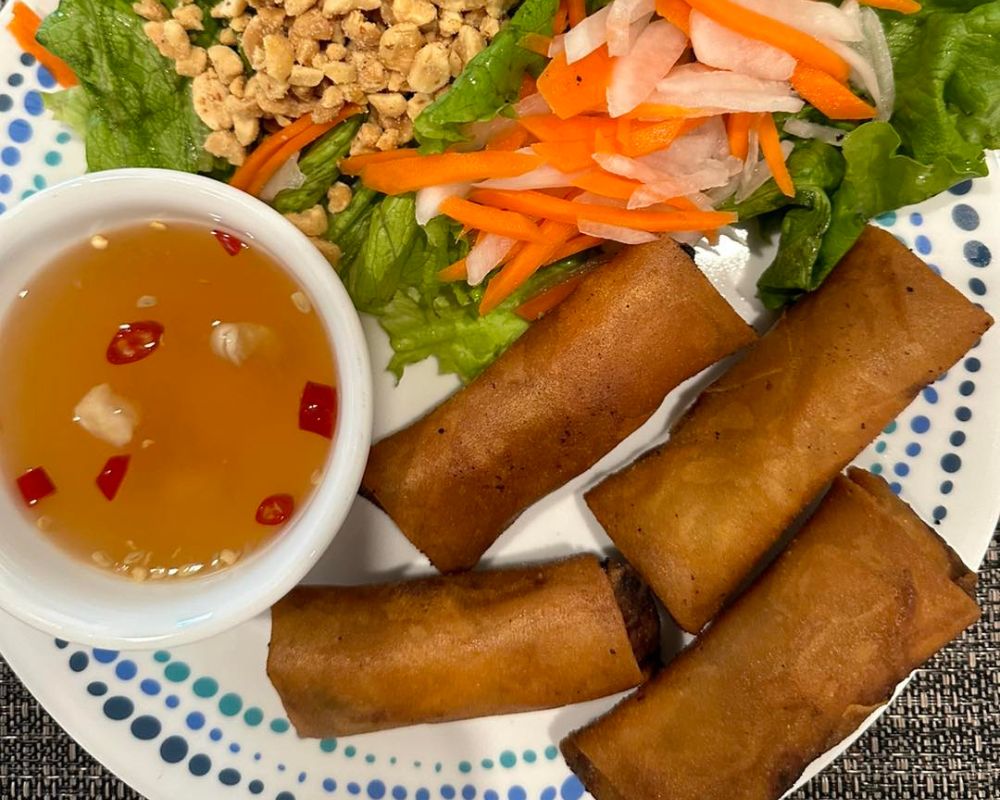
Chả Giò
The essence of Nem Rán lies in its deep-frying, which transforms the rolls into golden, crispy delights. The dipping sauce, a harmonious blend of lemon juice, sugar, chili, pepper, and fish sauce, complements the rolls, enhancing their flavors and adding a zesty kick.
It's a staple at both everyday meals and festive occasions like the Lunar New Year. It's often served with rice or noodles (Bún) and a side salad, embodying the richness of Vietnamese culinary traditions.
10. Bún Đậu Mắm Tôm (Vermicelli with Fried Tofu and Shrimp Paste)
Another popular dish, Vermicelli served with Tofu and Shrimp Paste (Bún đậu mắm tôm), is a testament to the diversity and accessibility of Vietnamese cuisine. Priced affordably, it's a favorite among all age groups, found everywhere from street corners to high-end restaurants.
The dish comprises noodles (Bún), fried tofu, trotter, Vietnamese sausage, and herbs, all presented on banana leaves. The distinctive shrimp paste, known for its potent aroma, is a crucial element, though diners wary of its intensity can opt for fish sauce as a milder alternative.
11. Chè (Sweet Soup)
Chè stands as a quintessential emblem of Vietnam street food, especially beloved in Saigon street food. This sweet dessert soup or pudding is a colorful medley of various beans and ingredients, offering a kaleidoscope of tastes and textures.
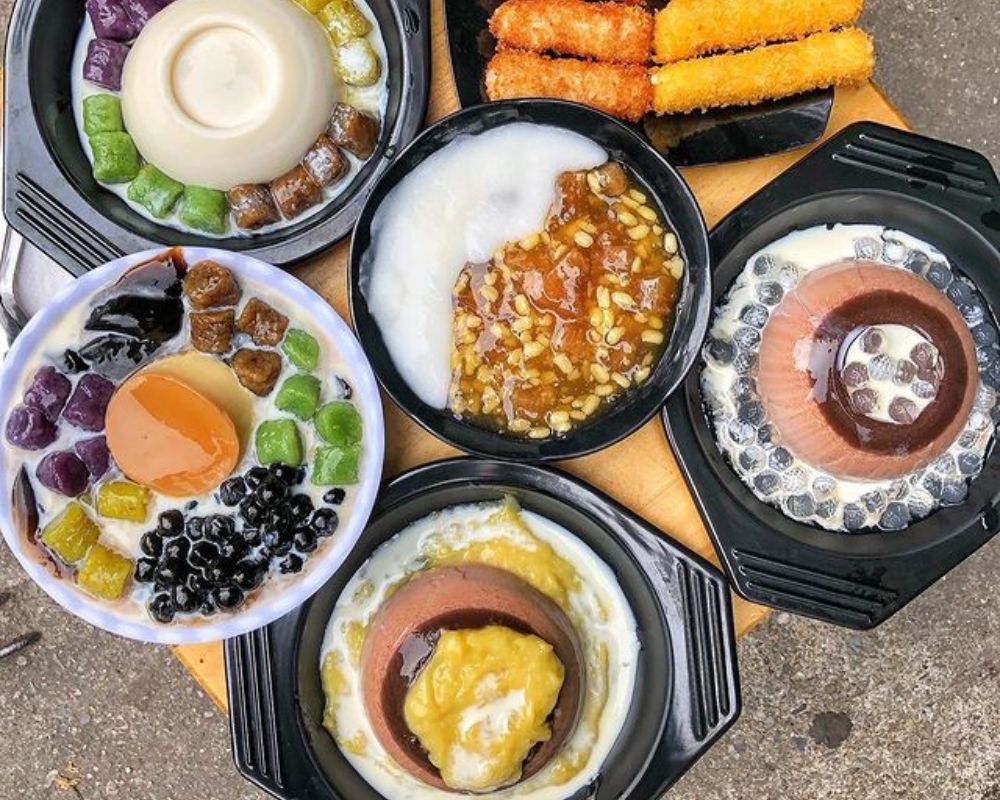
Chè bưởi and chè khoai dẻo
In Saigon, the diversity of Chè reflects not only the culinary breadth of Vietnam but also the influence of neighboring countries like Laos, Thailand, and Cambodia.
Each bowl is a vibrant composition, blending sweet flavors with the nuanced textures of beans and other components, making it a favorite treat among locals and visitors alike.
12. Bánh Xèo (Pancake)
Bánh Xèo, often referred to as crispy Vietnamese pancake, is another street food gem with roots that are commonly traced back to French culinary influence during their time in Vietnam.
The name 'xèo' mimics the sizzling sound of the rice batter hitting the hot skillet, a hallmark of its cooking process. Characterized by its golden, crispy exterior, Bánh Xèo is generously filled with ingredients such as boiled pork, shrimp, bean sprouts, and spring onion, creating a symphony of flavors and textures in each bite.
While utensils can be used, the most authentic and enjoyable way to consume Bánh Xèo is by hand, embracing the tactile experience of breaking off pieces and dipping them into the accompanying sauce.
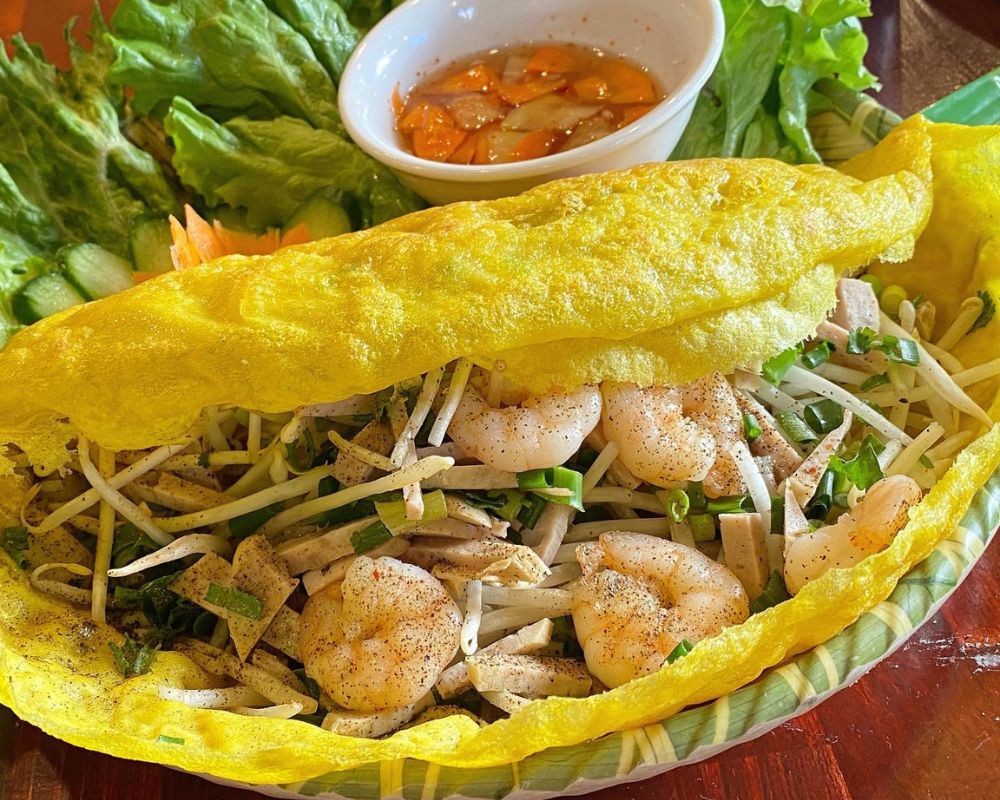
Bánh Xèo
This method of consumption connects eaters to the food in a more intimate manner, enhancing the overall culinary experience. Both Chè and Bánh Xèo embody the rich tapestry of Vietnamese street food, offering a glimpse into the country's diverse and vibrant food culture that captivates anyone who ventures to explore it.
13. Cơm Tấm (Broken Rice)
Cơm Tấm, or Broken Rice, is a staple in Vietnamese cuisine, particularly cherished in Saigon where it originated. Unlike regular rice, Cơm Tấm is made from fractured rice grains, offering a unique texture that's become a favorite for breakfast among locals.
This dish has transcended its humble beginnings to be a widespread favorite, available in restaurants throughout Vietnam.
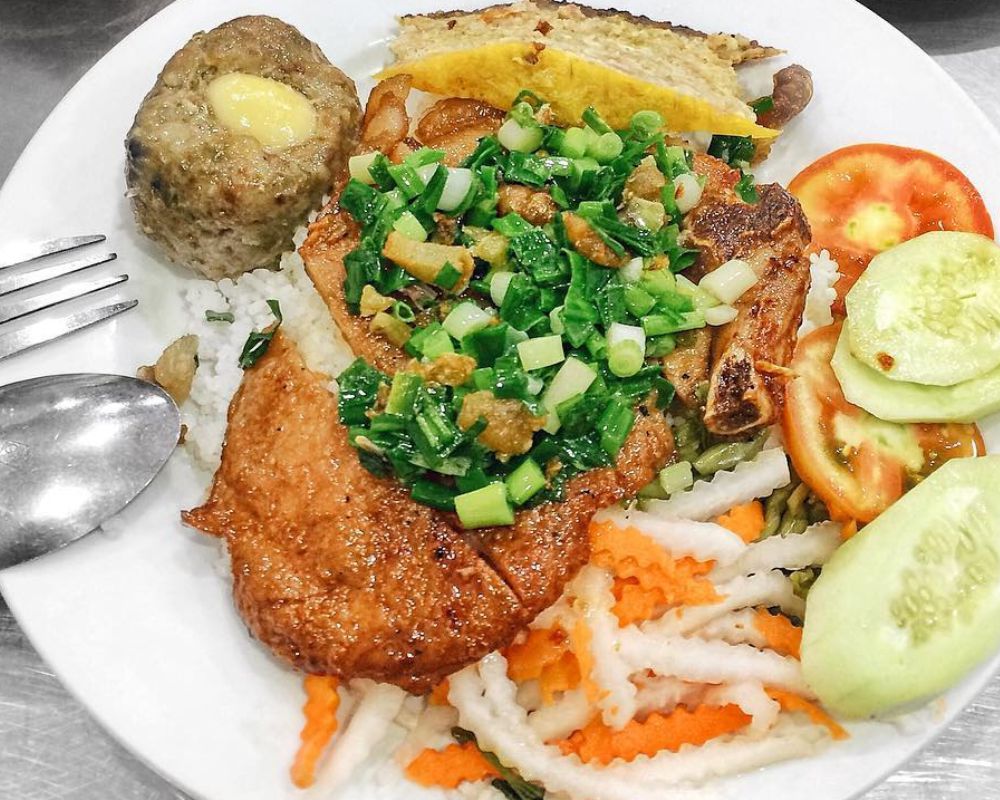
Cơm Tấm with grilled pork and chả
It's typically served with grilled pork (ribs or shredded), egg meatloaf, cucumber, carrot, spring onion, and a mix of vegetables tailored to diner preferences, accompanied by a small bowl of fish sauce and soup.
Interestingly, a fork and spoon are the utensils of choice for Cơm Tấm, allowing diners to fully appreciate the flavors and textures of this beloved dish.
14. Cà Phê Sữa Đá (Vietnamese Iced Coffee With Milk)
Cà Phê Sữa Đá, or Vietnamese Iced Coffee, embodies more than just a popular beverage; it symbolizes the rich history and vibrancy of Saigon, once known as the "Pearl of the Far East".
Prepared with a distinctive Vietnamese coffee filter, a dash of milk, and ice, it can be enjoyed in various settings, from bustling street corners to tranquil coffee shops.

Cà Phê Sữa Đá
Much like "Trà Đá" (iced tea) in Hanoi, Cà Phê Sữa Đá holds a special place in the hearts of both locals and tourists. It's a ritualistic brew, savored in the quiet of the morning or during leisurely weekend gatherings, marking moments of relaxation and camaraderie.
>> Read more: Top 20 Best Coffee Shops in Ho Chi Minh
15. Cao Lầu (Hoian Noodles)
Cao Lầu reflects the culinary heritage of Hoian, a picturesque ancient town in Quang Nam province. Distinguished by its yellow or gray rice noodles - a stark contrast to the white noodles of Phở - Cao Lầu is a harmonious blend of noodles, meat (typically pork or shrimp), greens, bean sprouts, and herbs, served with just a hint of broth.
The dish's sweetness, a nod to the southern and central palate's preference for sweeter flavors, sets it apart from other noodle dishes in Vietnam.
16. Bánh Tráng Nướng (Grilled Rice Paper)
Bánh Tráng Nướng, known as Vietnamese Pizza, is a street food sensation from Dalat. Crafted from rice paper and adorned with toppings like onion, shrimp, sausage, quail egg, and chili sauce, it's grilled until crispy.
This dish is enjoyed by breaking it into pizza-like slices, each bite delivering a crunch and warmth that's irresistibly appealing. Bánh Tráng Nướng's popularity is a testament to the creativity and diversity of Vietnamese street food, offering a unique taste experience that draws in locals and travelers alike.
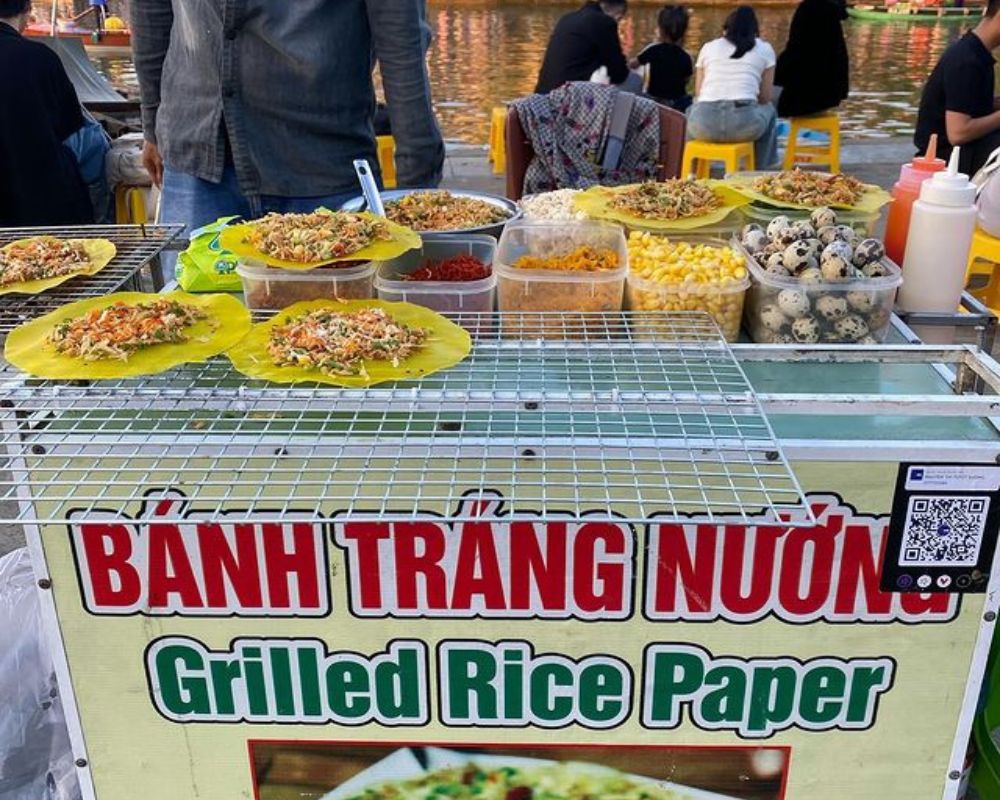
Bánh Tráng Nướng
Vietnam street food is a colorful cuisine of flavors and textures, each dish telling a story of its origins and the people who make it. Whether you're slurping a bowl of Phở on a busy Hanoi street or biting into a Bánh Mì by the Saigon riverside, you're experiencing the heart and soul of Vietnamese culture.
